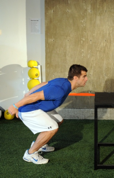High School Athletes Programming
By Wil Fleming
Recently I gave some thought to how many questions arise when putting
together programming for high school athletes. Questions about general strength
training practices, how to prioritize training goals, and what to do for speed and
agility are all important, but the most basic of questions that need to be asked by
any coach is:
What should be included in the program for your high school athletes?
As coaches we are all probably very familiar with the elements of a successful high school program in their entirety, but what are the finer points that can take your program for high school over the top?
Allow me to share with you the best ways to differentiate your program from all the others by looking at each phase of a high school training session:
SMR:A place to impact the health of athletes
A pre-workout program should do the job of preparing the athlete for the coming training and to some extent helping them recover from their prior training or practices. Foam rolling or other form of self-myofascial release should be included and should be mandatory prior to beginning that day’s session. High school programs and other coaches are doing SMR as an afterthought, by clearly laying out expectations for your athletes they will get more out of this part of the workout and be healthier.
Warm-Up:Continuity creates a great environment
Continuity in warm-ups creates the atmosphere at AR Bloomington, so
we stick with one for 2 months or so before altering it. In this way athletes
have very clear expectations of them and nearly all are able to achieve
some level of mastery within the warm-up period. I have also found that
a consistent warm-up is one of the single best times to create a fun and
exciting environment for the athletes through lively and interactive conversation.
Specific Mobility:Individualization
Specific mobility and activation should be differentiated by sport, position,
or athlete. We should take into account common movement patterns within
the sport, assessment results and injury history when designing this for each
athlete or group. No matter the size of the group, it is important that this time
be differentiated to keep athletes healthy, this touch of individualization even
in a large group goes a long way to insuring your athletes know that you took
into account their needs
Dynamic and Explosive Training:A difference maker
Dynamic and explosive training should consist of plyometrics and medicine
ball throws. This is a time for athletes to train their nervous system and train
fast twitch muscle fiber. In a lot of settings dynamic training gets thrown together
as an afterthought and sometimes looks like no more than “box jumps”. Smart
programming with progressions moving from: single response, to multiple
response, to shock, and unilateral work can greatly improve results for your
champions.
Speed and Agility:Basics first
Training for speed and agility can be the biggest opportunity for your AR to
be successful but so many programs go about it in the wrong way. Remember
that as with any other form of training, a foundation of technique should form
the basis of your training. Running mindless drills with no foundation will not
lead to success for your AR. Start with static drills, move to dynamic, and
finally move to randomization. Equip your athletes with the knowledge of
how to sprint, and how to change direction and they will be far better off than
any dot drill can make them.
Strength training:Choose to be different
Typically our high school athletes will be training with us concurrently with
a program run by their high school so we must take this into account. At most
high schools, athletes are trained predominantly through pushing movements
(squats, bench press etc), like the bench press and squat leaving their entire
posterior chain at a deficit to their front-side musculature. Balance your athletes
out by programming more “pulling” than “pushing”.
Energy Systems Training: So much more than just running
Athletes are very familiar with running mile after mile or “gasser” after “gasser”.
Exposing athletes to innovative energy systems training by using different
implements e.g. kettlebells or medicine balls, and by using exact intervals to
elicit particular responses, shows creativity on your part, allows you to use
your space more efficiently, and will make you a savior to your champions.
Flexibility:A final time to teach
Whether from the coach or the athlete flexibility gets a bad rap. Although
not as buzzworthy as mobility, training athletes for flexibility will undoubtedly
be to their benefit, if only for its use as a cool down. As a coach the time for
flexibility is a time for a wrap up of the days events and reminders for
upcoming events. It is your final time to connect with athletes in that given
day. Use it well.
Using this framework for how you approach the programming of your
high school athletes will help you get them more invested and excited to be a
part of your High School Athletes, and make them better.
Remember that we are here to Change Lives!


